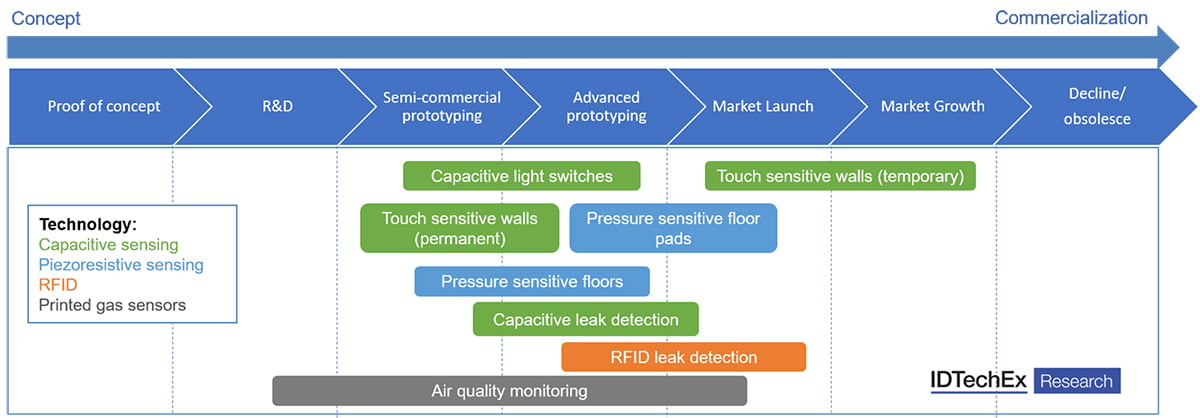Smart buildings promise automated control of the buildings’ operations, along with integrated technology for human-machine interactions. Such functionality requires multiple sensors, to which printed/flexible electronics are very well suited due to their low weight and thin-film form factor. Indeed, the building of the future may have printed sensors built into the walls, floor, and ceiling to detect water leaks, air quality, usage patterns, and more. Extensive discussion and analysis of many printed/flexible types can be found in the IDTechEx report “Printed and Flexible Sensors 2020-2030: Technologies, Players, Forecasts”.
Q3 2020 hedge fund letters, conferences and more
Touch-Sensitive Walls
A long-cited advantage of printed/flexible electronics is their compatibility with low-cost, large-area manufacturing. However, to date, these attributes have not been widely utilized, with the greatest adoption in high-value applications such as OLED displays.
Given the large areas involved, low-cost manufacturing is essential for some building-integrated applications such as touch-sensitive walls. This functionality is achieved by printing carbon-based conductive inks with conventional graphics printers. By arranging multiple capacitive sensors underneath decorative graphics, people can interact with the ‘wall’ to produce light and sound (generally produced via conventional electronics at this stage). Currently, this application of printed electronics is used primarily for promotional purposes, such as marketing campaigns.
Touchless light switches using capacitive touch are another application that utilizes the ability of capacitive sensors to detect the proximity of conductive objects (such as hands) rather than pressure. Given the current COVID-19 situation, technology that enables contactless switching is attracting increased interest.
Pressure-Sensitive Floors
Pressure sensors have long been manufactured using screen printing of both conductive inks and a force-sensitive resistive material, with car occupancy sensors the most common application. The low production costs mean that these sensors can be used to cover very large areas such as flooring. Potential applications include monitoring customers in a shop or patients in a hospital, without the privacy concerns associated with cameras. Pressure-sensitive floor pads have also been developed and deployed in shops to help enforce COVID-19 social distancing requirements.
Leak Detection
An innovative and commercially available interior application is thin-film moisture sensors. These determine humidity using a printed antenna that is read remotely by an RFID reader, enabling non-destructive measurement. The basic principle is that a moisture sensitive layer changes the resonant frequency of the antenna. The thin-film format enables the sensor to be placed behind waterproof tiles to check the waterproofing efficacy.
Capacitive sensors can also be used to sense water, which is why your smartphone screen doesn’t work in the rain. By using cheap carbon-based ink printed onto reels of plastic, a thin strip of leak detective material can be cost-effectively spread around the perimeter of a room. The sensors communicate wirelessly with the cloud whenever a change in capacitance is detected, with most of the processing performed in the cloud.
Gas Sensing For Air Quality
Air quality is an increasingly monitored metric throughout the world, as the health consequences of poor air quality become apparent. To date, most gas sensors are made from inorganic materials and are thus rigid, making them more conspicuous and difficult to install.
Gas sensors made from printed/flexible electronics offer a thin film alternative that can potentially be produced at a lower cost due to their compatibility with continuous low-temperature manufacturing. Such gas sensors typically comprise an array of functionalized materials such as carbon nanotubes, with the conductivity of each changed by the absorption of gas molecules. Algorithmically analyzing the output from all the gas sensors in the array then enables the composition of specific gases to be determined. Obtaining this information in real-time throughout a building would enable the air circulation rate to be modified as appropriate and provide early warning of high pollutant levels.
Readiness Level Assessment
To summarize, printed/flexible electronics are well suited to building integrated applications due to their light weight and potential for low-cost large-area manufacturing. Figure 1 shows IDTechEx’s assessment of technological and commercial readiness for the applications outlined above.
Figure 1: Technological and commercial readiness level assessment for the outlined applications. Source: IDTechEx






